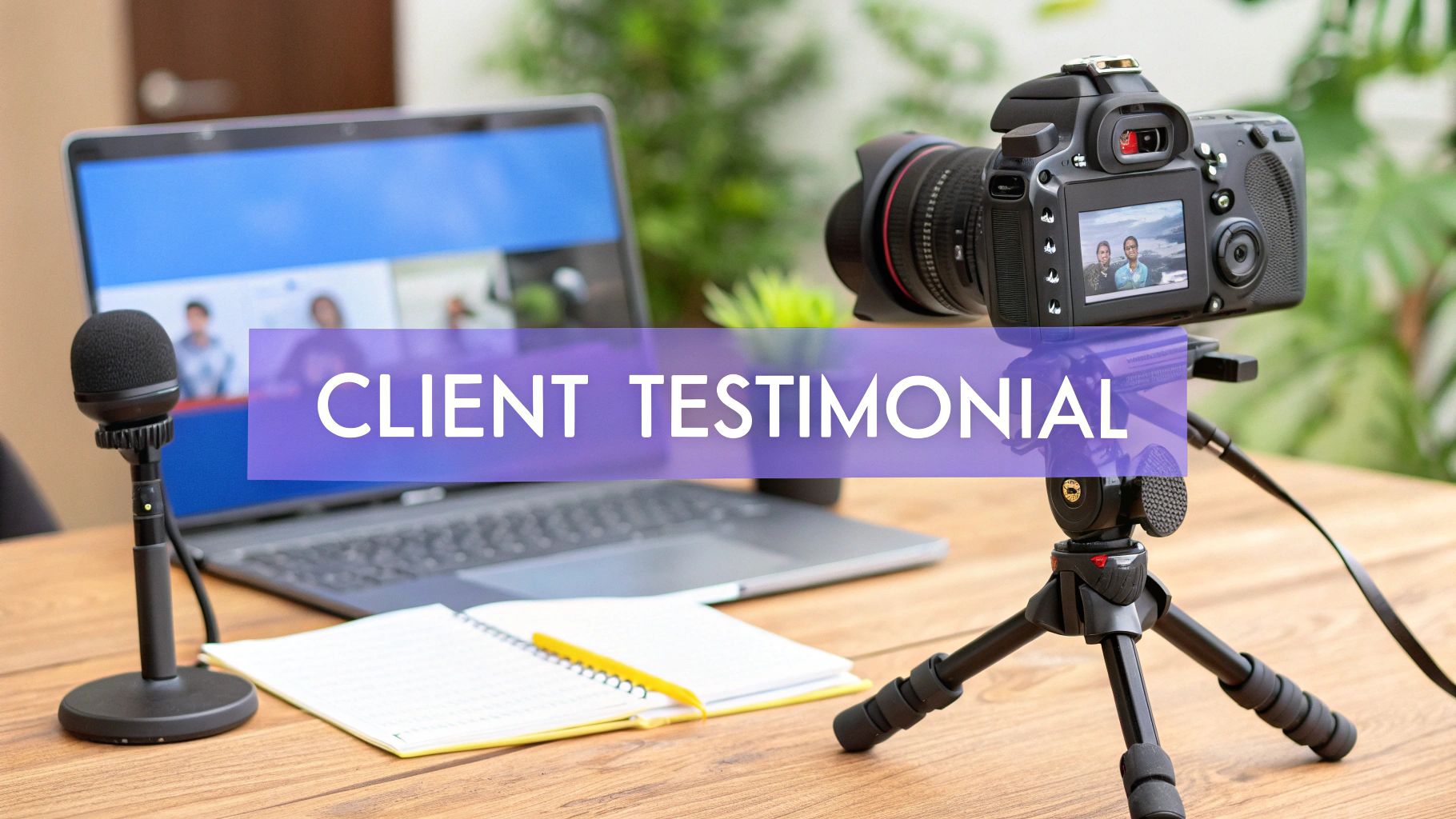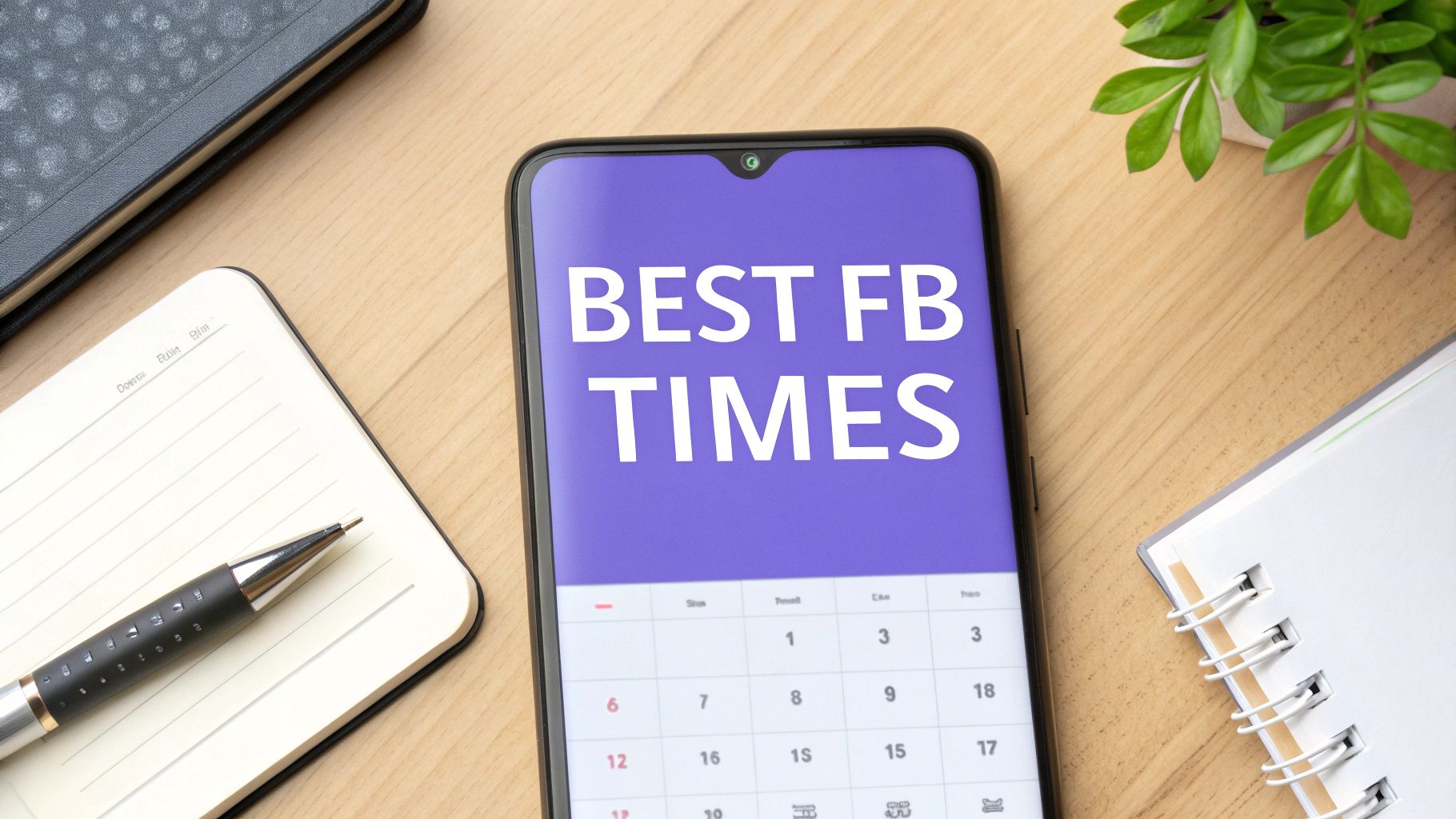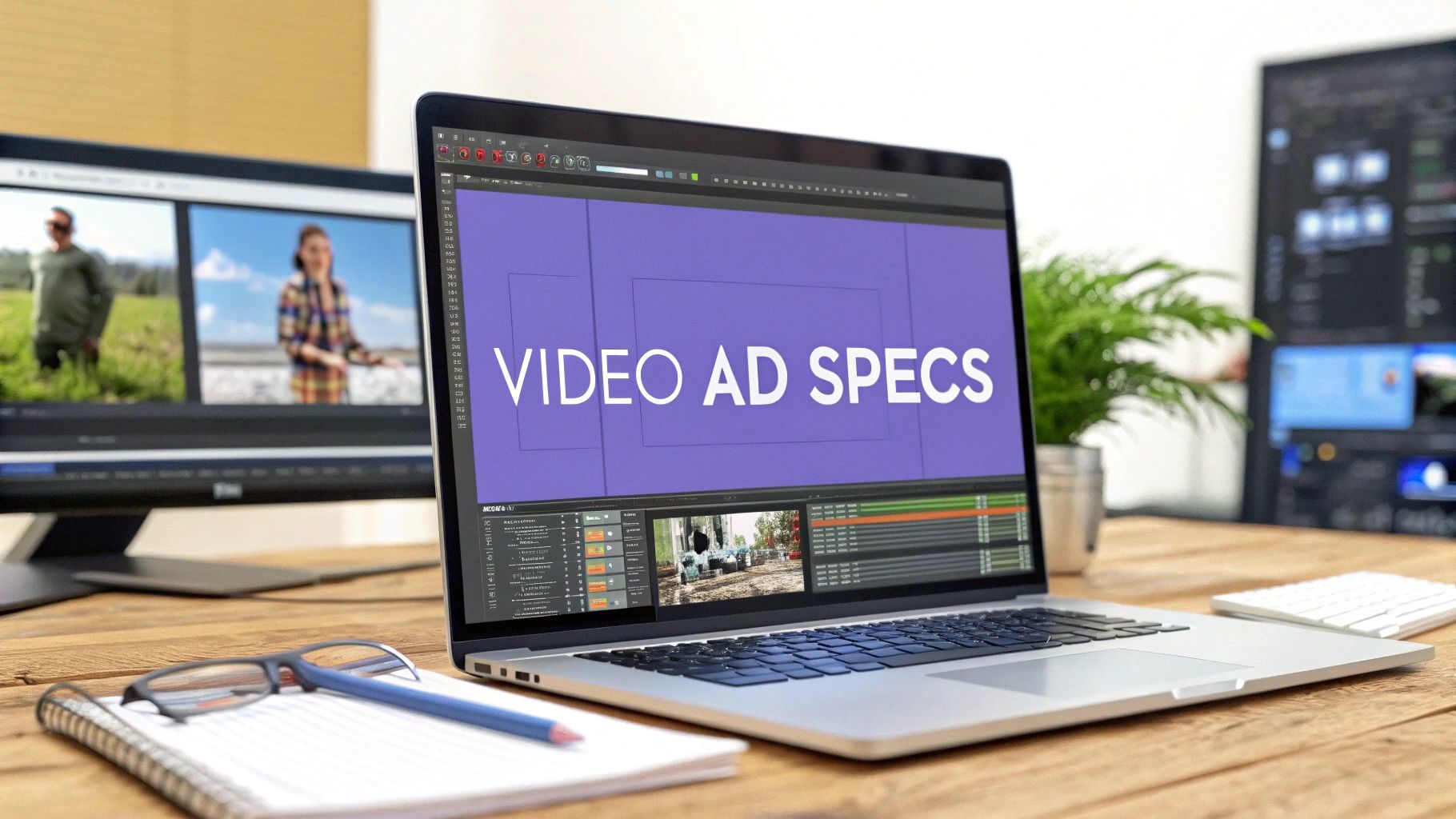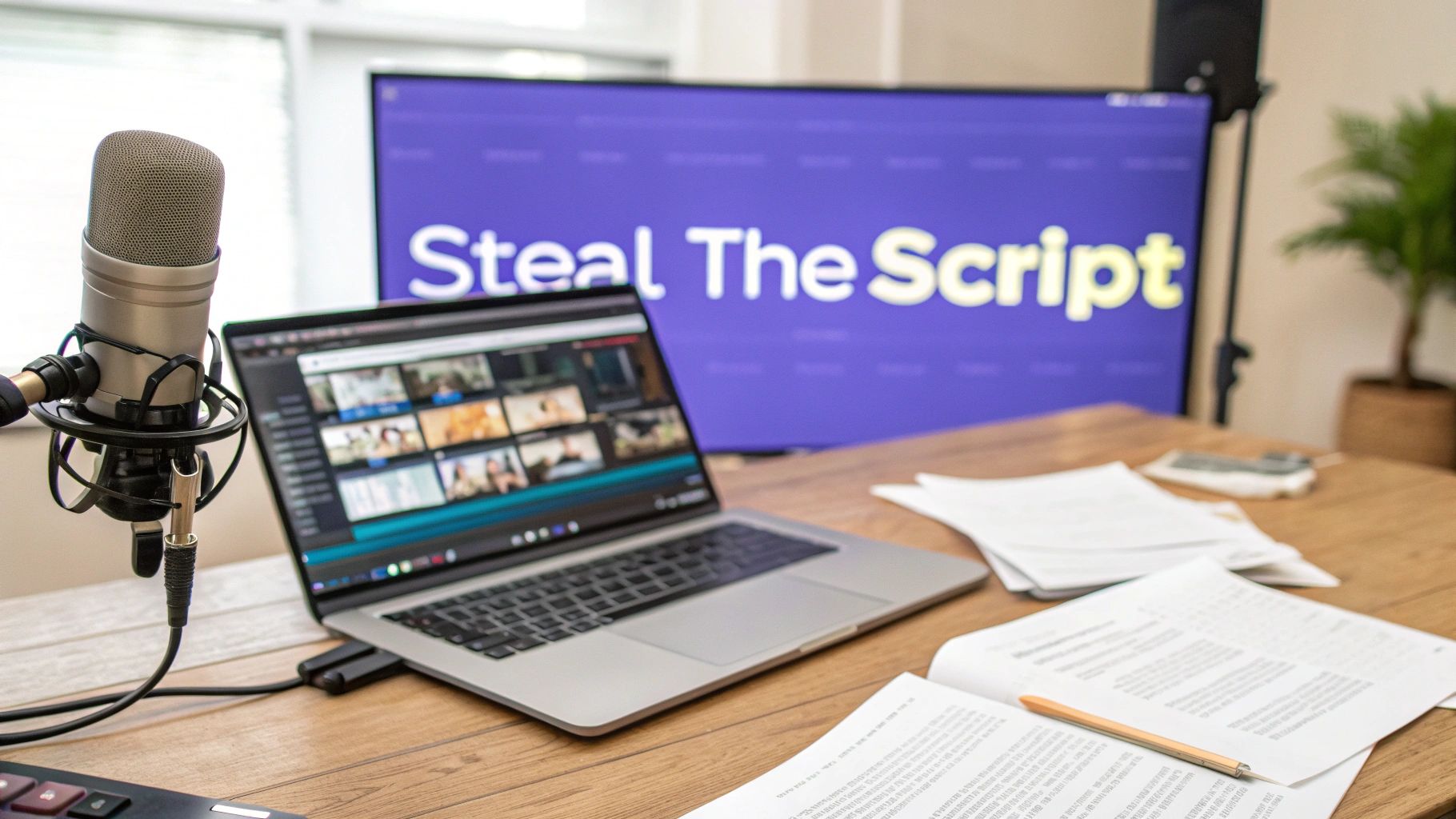A client testimonial video is one of the most powerful tools in your marketing arsenal. It’s simply a video where a happy customer talks about their real-world experience with your product or service. Forget sales pitches—this is the digital equivalent of a friend enthusiastically recommending something they love.
It provides authentic social proof that builds instant trust with people considering your brand.
Why Testimonial Videos Are So Incredibly Persuasive
Let's face it: today’s buyers are smart. They can spot a polished marketing message from a mile away and have become masters at tuning out traditional ads. This is exactly where a genuine client testimonial video shines. It cuts through all that noise because it isn’t your company making claims; it’s a real customer sharing their own story.
Hearing directly from someone who has walked in their shoes, faced the same problems, and found a solution with your help creates an immediate, human connection. The unscripted emotion and relatable details build a level of trust that a slick corporate video just can't match.
The Power of Authentic Social Proof
We’re all influenced by what others do. It’s a psychological principle called social proof, where we look to others to guide our own decisions. A client testimonial video is this principle in action.
When a potential customer sees a real person—someone just like them—vouching for your business, it speaks directly to their doubts and hesitations. This isn't just about showing off a happy client; it's about proving your value through a credible, third-party voice.
These videos do more than just build good vibes. They can actually shorten the sales cycle by answering questions and handling objections before a prospect even talks to your team. They put a human face on your brand, turning abstract benefits into tangible success stories. For some great inspiration, check out these powerful testimonial ads examples to see how other brands are doing it right.
Driving Real, Measurable Results
The impact of video testimonials isn't just a gut feeling; the numbers back it up. We’re talking about significant lifts in conversions, shorter sales cycles, and much higher engagement.
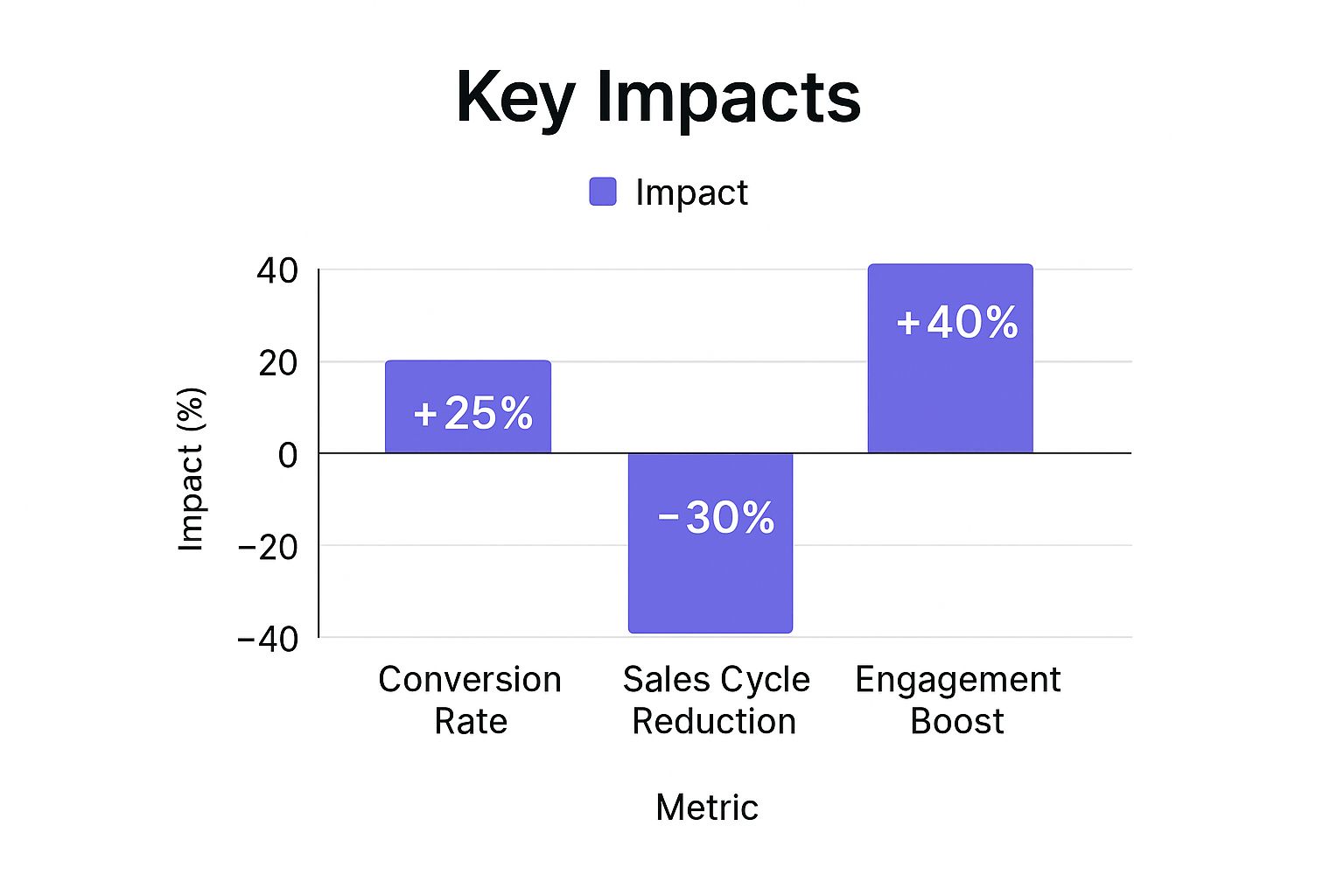
While a glowing written review is good, a video is on another level. Seeing and hearing a customer share their story creates a much deeper emotional connection and is far more memorable.
Here’s a quick breakdown of how video stacks up against text.
Testimonial Format Impact Comparison
| Metric | Video Testimonial | Text Review |
|---|---|---|
| Trust & Authenticity | High (viewers see genuine emotion) | Moderate (can feel curated or fake) |
| Emotional Impact | Very High (tone and body language add depth) | Low (relies solely on the reader's interpretation) |
| Memorability | High (visual and auditory cues aid recall) | Low (easily forgotten among other text) |
| Engagement | High (people prefer watching over reading) | Low (often skimmed or ignored) |
| Conversion Lift | Significant (up to 25% or more) | Modest (builds some credibility but less impact) |
The takeaway is clear: video is simply more compelling. It captures the nuance and sincerity that text just can't convey, making it a far more effective tool for turning prospects into customers.
Laying the Groundwork for a Great Video

A truly compelling client testimonial video is won long before you even think about hitting the record button. All the magic happens in the planning. This initial groundwork is what separates a generic, forgettable video from one that genuinely connects with your audience and gets them to act.
This phase is all about strategy. It’s where you pinpoint the perfect client, nail down a crystal-clear objective, and sort out the logistics to make sure the whole production runs smoothly. Getting this part right makes everything else—from scripting to shooting—so much easier and far more effective.
Find Your Ideal Storyteller
Not every happy customer is the right fit for a video. You're not just looking for someone who likes your product; you're looking for a great storyteller. The best person is someone who can clearly and enthusiastically explain the value they got from working with you.
Think about clients who have seen incredible, measurable results. Who has a compelling "before-and-after" story that will really hit home with your ideal prospects? You want someone who is not only a fan of your brand but also comfortable and articulate on camera.
Key Takeaway: The goal isn't just to find a satisfied client, but a true brand advocate. Their genuine excitement is the most powerful part of the video, creating an authentic connection that no amount of branded content can ever replicate.
A big piece of this is knowing how to ask for testimonials effectively. A personalized, appreciative, and low-pressure request is your best bet for getting an enthusiastic "yes!"
Define a Single, Clear Goal
Before you do anything else, ask yourself one critical question: What, exactly, do I want this video to achieve? Without a specific goal, your video will feel scattered and lose its punch. Your objective shapes every decision you make, from the questions you ask to the final edit.
Your goal could be anything, really. Maybe you're trying to boost sign-ups on a product landing page. Or perhaps you want to build some brand buzz on social media. Each goal demands a totally different approach.
Here are a few common objectives to get you thinking:
- Increase Conversions: A short, powerful video placed right next to a call-to-action can be the final nudge a customer needs.
- Build Trust: A longer, more in-depth story works wonders on your homepage or "About Us" page to build credibility with new visitors.
- Support Sales: A video that addresses specific pain points can be a game-changer for your sales team to share with potential clients.
- Boost Social Engagement: A quick, snappy clip with captions is perfect for grabbing attention on platforms like LinkedIn or Instagram.
Handle the Pre-Production Logistics
Okay, you've got your client and your goal. Now it’s time to nail down the logistics. Smooth coordination is key to a stress-free experience for everyone involved.
Start by putting together a simple prep guide. This isn't a script. It’s just a brief document that outlines the topics you'll cover, gives a time estimate, and lets them know what to expect on the day of the shoot. This small step does wonders for their confidence and helps them feel prepared.
Next, lock in the schedule and location. Whether you're filming in person or remotely, pick a time that’s super convenient for your client. For remote shoots, give them simple instructions for setting up their camera and making sure their lighting and audio are solid. If you're filming in person, find a spot that’s quiet, well-lit, and visually reflects your brand’s style.
Guiding the Story Without Sounding Scripted
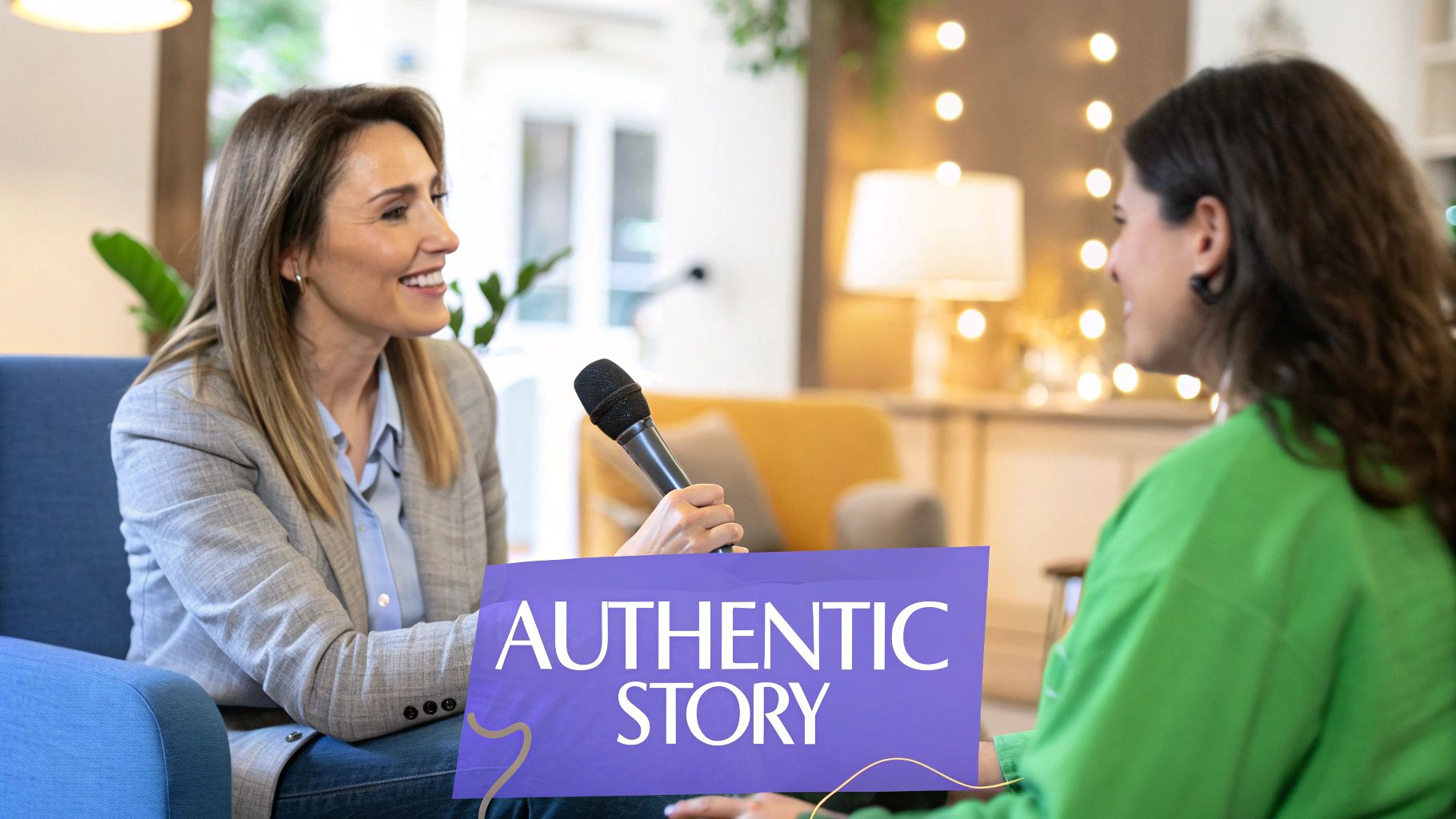
The fastest way to drain the life out of a client testimonial is to make it sound like a rehearsed sales pitch. Authenticity is everything here, and a rigid script is its greatest enemy.
Your job isn't to put words in your client’s mouth. It's to create a comfortable space where their real story can unfold naturally.
Instead of a script, think in terms of a simple storytelling framework. I’ve found the most effective structure is timeless: Problem, Solution, Result. This narrative arc is easy for anyone to follow and naturally creates a compelling story for your audience. It gives the conversation a clear direction without forcing anyone to read stilted, pre-written lines.
The Problem-Solution-Result Framework
This simple framework guides the conversation from your client’s initial frustrations to their ultimate success. It’s a natural way to tell a story that connects with potential customers who are stuck with those same challenges. The goal is to build a narrative that is both relatable and aspirational.
- Problem: Kick things off by digging into the challenges they faced before they found you. What was the specific pain point that finally pushed them to look for a solution? Get them to relive that frustration a little bit.
- Solution: Next, pivot to their experience finding and using your product or service. What was it like getting started? What specific features or moments stood out?
- Result: Finally, land on the tangible outcomes. How, specifically, did your solution make things better? This is where you gently push for numbers and metrics if they have them.
To bring this framework to life, you have to ask the right questions. The key is to use open-ended questions that pull out detailed, thoughtful answers, not just a simple "yes" or "no."
Pro Tip: Avoid leading questions like, "Did you love how easy our software was to use?" That just begs for a one-word answer. Instead, try something like, "Can you walk me through your experience getting started with our software?" The second one invites a real story, not just a confirmation.
Crafting Questions That Spark Great Answers
Think of your questions as the keys that unlock the best parts of the story. You're less of an interviewer and more of a journalist trying to get to the heart of what happened. A well-phrased question can be the difference between a generic, forgettable answer and a powerful, emotional soundbite.
Here are a few questions I keep in my back pocket that almost always get great results:
- "Before you found us, what was your biggest frustration with [their specific problem]?"
- "Can you describe the moment you realized this was actually working for you?"
- "What's one unexpected benefit you've experienced since we started working together?"
- "If you were recommending us to a friend, what's the very first thing you would tell them?"
While AI tools can be great for brainstorming a long list of questions, the real magic happens in the moment. A real conversation involves active listening and asking follow-up questions. Be ready to go off-script and dig deeper when your client says something interesting.
That flexibility is what captures the unscripted moments that make a client testimonial video feel real and, ultimately, believable.
Shooting a Professional Video on Any Budget
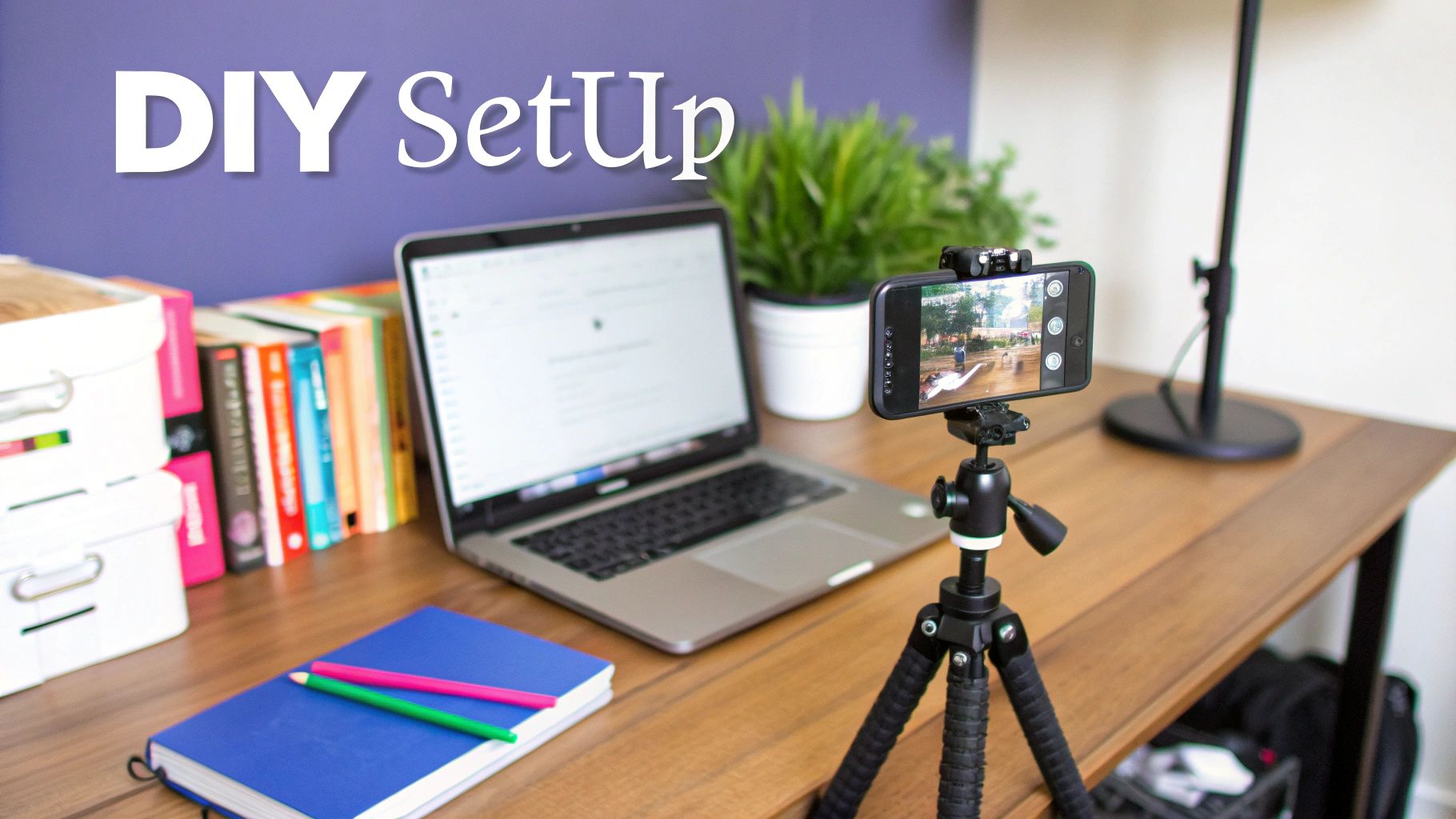
Let's get one thing straight: you don't need a Hollywood budget to produce a client testimonial that truly connects with people. While having a full production crew is great, you can absolutely create something polished and professional with smart planning and a focus on the fundamentals. It's all about knowing where to put your energy.
The best part? Authenticity beats cinematic gloss every time. Your audience wants a real story from a real person, not a Super Bowl commercial. Your job is simply to make sure your client looks and sounds their best, so their message comes through loud and clear without any technical hiccups.
Mastering the DIY Video Setup
Getting a high-quality shot yourself is easier than ever. The camera in your pocket is probably incredible, but a great video is about more than just the lens. If you only focus on two things, make them audio and lighting.
Bad audio is the number one killer of good video. Seriously. People will forgive a slightly grainy image, but they’ll click away in a heartbeat if they can't understand what's being said. A simple lavalier mic (the little clip-on kind) is a cheap and massive upgrade over your phone’s built-in microphone.
Lighting is just as important. You don't need a truck full of expensive gear. A room with lots of natural light is your best friend. Just have your client face a window—this creates soft, even light on their face and avoids those harsh, distracting shadows. A clean, simple background helps keep the focus where it belongs: on them.
Remote Recording Made Easy
What happens when your happiest client lives halfway around the world? No problem. Modern remote video platforms make it incredibly simple to capture high-quality footage from anywhere. You just send your client a link, and it opens up a recording studio right in their web browser.
This approach is a game-changer for a few reasons:
- It’s a guided experience. The platform can show your questions on-screen, walking your client through the interview step-by-step.
- You get high-quality footage. These tools record the video directly on your client's computer before uploading, which means the quality is way better than a choppy Zoom call.
- It’s incredibly convenient. Your client can record whenever it works for them. No more trying to coordinate schedules across different time zones.
Getting the quality right isn’t just about looking good; it's about building trust. A staggering 91% of consumers say video quality directly impacts how much they trust a brand. And when asked how they prefer to learn about a product, 78% pick video. These numbers, from Wyzowl's latest video marketing report, show why a clean, professional testimonial is such a powerful marketing tool.
When to Hire a Freelancer
If you’ve got a little room in the budget and want to step up your game, bringing in a freelance videographer is a fantastic move. They’ll have all the professional gear—the right cameras, lights, and audio equipment—and, more importantly, they know how to use it.
Hiring a pro lets you stop worrying about the technical stuff. You can focus entirely on making your client feel comfortable and guiding a great conversation. That small investment can pay for itself with a final video that looks incredible and makes your customer’s story even more powerful.
Editing Your Footage Into a Compelling Story
https://www.youtube.com/embed/HdvTO9rvSm4
You've got the raw footage, and it’s packed with potential. Now for the fun part: the edit. This is where you transform what might be an hour of conversation into a tight, powerful story that actually moves people. Your job here isn't just to cut clips together; it's to become a master storyteller.
Think of yourself as a gold miner. You’re sifting through all that footage to find the “golden nuggets”—those perfect soundbites where your client’s voice cracks with genuine emotion, where they vividly describe a problem they were stuck on, or where their face lights up talking about the solution. These moments are everything. They're the foundation of your final video.
Speed Up Your Workflow with AI Editors
In the past, this was a painstaking process. But today, AI-powered editing tools have completely changed the game. These platforms take the most tedious, time-sucking parts of post-production off your plate, so you can focus on the creative side of things.
Instead of manually scrubbing through hours of video, you can now edit from a text transcript. It’s a huge shift in workflow.
Many of these AI editors can automatically:
- Generate a full transcript: This lays out the entire interview in text, making it incredibly easy to scan and find the best lines.
- Remove filler words: All those "ums," "ahs," and awkward pauses? Gone in a single click. The audio is instantly cleaner.
- Create a rough cut: Some tools are smart enough to identify the most engaging parts of the conversation and assemble a first draft for you.
This text-based approach is brilliant. If you want to cut a section of video, you just delete the corresponding sentence in the transcript. It turns a technical task into something as simple as editing a Word doc. This slashes production time, which is often the biggest hurdle.
In fact, a recent report on video testimonial statistics found that 89% of enterprise organizations would create at least 50% more testimonial videos if the process just wasn’t so time-consuming.
Adding the Essential Finishing Touches
Once you have the core story locked in, it’s time to add the polish that makes it look professional and keeps viewers engaged. These final elements are what separate an amateur video from a truly great one.
First, layer in your B-roll footage. This is supplemental video that adds context and visual interest. For instance, while your client is talking about how a feature saved them time, you can cut to a quick shot of that feature in action. It makes their story so much more real and believable.
Next, add your on-brand graphics. This includes your logo and lower-thirds (the text at the bottom of the screen that introduces your client with their name and company). Then, pick some background music that matches the emotional arc of the video—is it inspiring, serious, or high-energy?
And finally, always add captions. A huge number of people watch videos on social media with the sound off, especially on their phones. Captions ensure your message isn't lost. They also make your content accessible to everyone. If your video needs a bit more narrative guidance, a simple voice-over can work wonders. If you need help with that, our guide on how to voice over videos has some great tips.
Where to Share Your Video for Maximum Impact
You’ve created an amazing client testimonial video. That’s a huge win, but the work isn't over yet. If that video just collects digital dust on a server somewhere, it’s not doing you any good. A smart, multi-channel distribution plan is what turns that powerful story into a real business asset.
The goal isn't just racking up views; it's about getting the right views. You want to place your video exactly where your ideal customers are hanging out, right when they're thinking about making a purchase. Think of it like putting your best salesperson in all the right rooms at once.
Your Website is Home Base
Your own website is the most powerful place to feature your new video. It’s your turf, a space where you control the entire experience and can guide what a visitor does next. Don't just bury it on a "Case Studies" page that no one visits. Put it front and center.
Here are a few high-impact spots I always recommend:
- Your Homepage: Placing it "above the fold" immediately builds trust and credibility with anyone who lands on your site.
- Key Landing Pages: Drop the video right next to a "buy now" or "request a demo" button on a product page. It can be the final nudge someone needs to take action.
- Pricing Pages: Seeing a genuinely happy customer can ease any sticker shock and make the investment feel much more justified.
- Sales Proposals: Embed the video directly into your digital proposals. It gives your prospects a compelling, emotional reason to sign on the dotted line.
Slice, Dice, and Share Everywhere
One video is never just one video. It’s a goldmine of content that can be chopped up and repurposed for pretty much any platform you can think of. This stretches its lifespan and gives you a much bigger return on your effort. You can learn more about the best places to share your work by exploring different video distribution platforms.
A Quick Tip: A "one-size-fits-all" approach to video is a recipe for getting ignored. Every social platform has its own vibe, audience, and preferred format. Tailoring your content is the key to grabbing attention.
Think about creating a few different cuts for different channels:
- LinkedIn: A 60-second, square-formatted clip with big, bold captions is perfect for stopping the scroll in a professional feed.
- Instagram Reels/TikTok: Pull the most emotional or surprising soundbite and turn it into a short, vertical clip. These can go viral.
- YouTube: This is the best place for the full-length video. Make sure to optimize the title and description with keywords people are searching for.
- Email Newsletters: Instead of a static image, use an animated GIF from the video that links out to the full version on your site. It’s way more engaging and drives traffic back home.
For an extra boost, digging into some effective local SEO tips and customer story videos can help you get seen by the right local audience. By strategically sharing your client's success story across these different channels, you meet potential customers right where they are and make sure all your hard work actually pays off.
Ready to create stunning, high-converting videos without the complexity? Sprello helps you produce social ads and content in minutes using AI, eliminating the need for filming or intricate editing. Start producing more videos and learning what converts faster. Check out Sprello and see how easy it can be.
